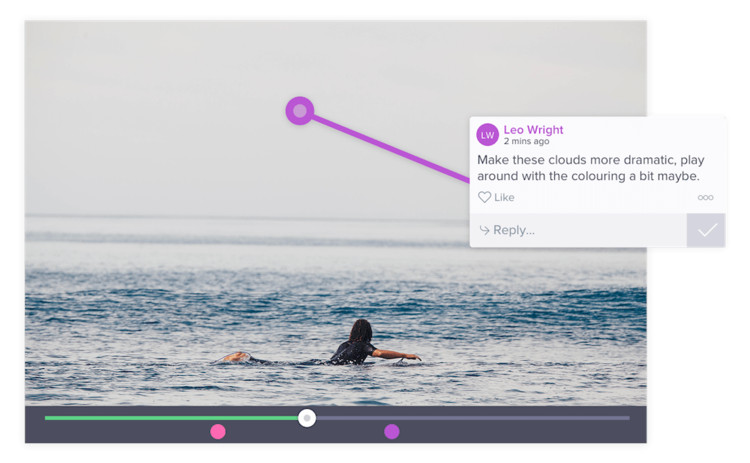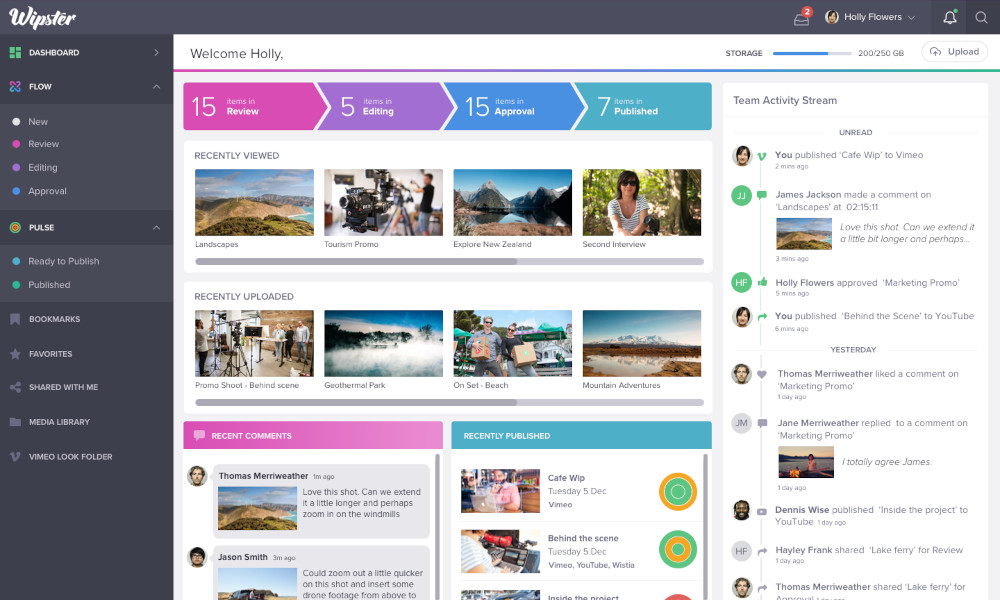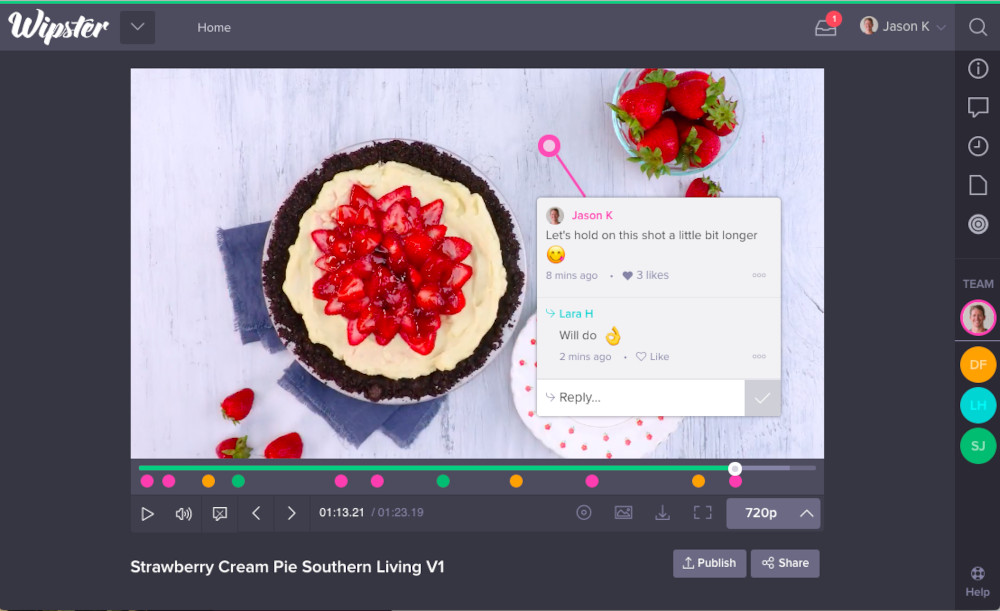What is Wipster? (and how did they go from NZ startup to global leader?)

One of the challenges that companies (and creators) face today is that of scale.
Specifically, scale of content.
As Gary Vaynerchuk famously said, we need to become a media company first, and a <insert whatever industry we’re in> company second.
The idea being, that in this digital age, when we’re awash with social media content, advertising, and information at volumes unlike we’ve ever seen before, we’d better be putting out more valuable content than the next person, or we will cease to be noticed.
So, we write blog posts that offer valuable ideas and information, we create and share images to entertain or inform, and increasingly, we create video content - to do all of the above.
But as anyone who has worked with video or image creatives for a company or client can attest - the first version of a piece of creative is rarely the one that gets the go-ahead.
So what do we do? Well, all over the world, video creators are uploading video versions to dropbox or other cloud hosting service, then emailing links to their client or colleagues requesting feedback, and thus beginning their descent into madness!
Ok, ok, slight artistic license being taken there - but you get the idea.
The fact remains, anyone who has been involved in creating (or approving) large quantities of creative knows all too well the endless mishmash of email chains, instant messages, disjointed conversations, and incomprehensible video version filename conventions… (video_final_4_actual_7b_final_version3.mp4 anyone?)
Well, today all that ends - and to help navigate these waters, I’m talking with Rollo Wenlock, co-founder of Wipster, a creative review platform created in little old Wellington, New Zealand, and now trusted by thousands of companies around the World.

What is Wipster?
Wipster is a creative review platform to share feedback.
Who is Wipster for?
The people who need to review creative assets, and the people who make them.
What are your favourite features of the platform?
Being able to click on any part of an asset and make a comment, and then in realtime, seeing people reply.
I love the origin story of Wipster. Early one morning, holding your new baby while looking out the window, the rays of the sunrise illuminate dust on the pane of glass, causing you to change your focus from the view outside to the window pane. A lightbulb moment – why not layer feedback comments over the top of videos for review? Talk to us about the weeks and months that followed, seeing that idea become a reality.
It was a time of quickly trying to prove that it wouldn’t work (rather than trying to prove that it should).
We entered startup pitch competitions, accelerators, and met with people in the startup world. I’d never done anything like this before, so it was all new and exciting.
We won some pitches, we got into the accelerator, we started to meet investors, and then we were off getting customers and building features.

You pitched your start-up idea early on to investors to secure additional funding. Where was this funding destined? Talk us through this phase of your company’s growth.
The funding was to keep the founders alive on meager salaries and hire a couple of extra developers. As we built more of the product based on customer feedback, we got more customers… over time we raised more money to do marketing and then enterprise sales.
How important to you is customer feedback? How does Wipster gather meaningful input, to help build a product that surprises and delights its customers?
Once you’ve got the kernel of the product and you’ve proven people need it (they pay), it’s then all about customer feedback. We do feedback sessions, surveys, and onsite visits to watch them work. Once we’ve got new stuff built we always put it through a beta process to refine before releasing.

Being a SaaS (Software As A Service) platform, Wipster is obviously enabled by the internet. Your customers use your cloud-hosted service, and upload countless video files and so on for feedback, changes and approval. You also have team members across several New Zealand and US cities. How do you think about the internet as an enabler of innovation, and how does Wipster lean into that?
So much of what is shared within a business is digital files of one sort or another.
Any products that shorten the lag between sharing and getting feedback (signing docs for example) are making the remote experience more and more possible for more and more people.
Our product is a real-time feedback loop for creatives and their customers, everything we add to the product is aimed at making that more seamless.
These days you have a thriving SaaS business, with thousands of customers, including numerous high-profile companies from around the world. I see iconic names such as Apple, Dell, Xero, Deloitte, Shopify, Time Inc, NBC, Shimano and others. Talk to us about when you started bringing on your first customers. How exciting was that first “proof” that you were onto something? What was the growth trajectory of the company, and can you tell us what it was like to secure your first major US company as a customer?
In the early days, it was all about people signing up to the product online without interacting with the team. We’d watch the stream of email address of the new accounts and start seeing well known US brands, that was exciting.
Once these accounts got really big we’d be approached by their security team to make sure we weren’t cowboys/girls - which we were, so then we started to build enterprise features.
Our average customer was worth around $450 per year to us, we then closed our first enterprise deal of $270,000 - that was an amazing feeling.
Are there any interesting metrics or milestones you can share with us about Wipsters growth over the years?
There is a counter intuitive one - the more you use Wipster, the less you need to use it. When the review process is smooth and fast, there are less versions.
We see our customers expanding usage by making MORE stuff.
In terms of the core product, you started out a video review platform, and have kept adding features that you believe creative teams and their customers would find delightful to use. I see you have moved into other creative, such as images. How do you and your team identify features to be added, and prioritise these?
A lot of it is based on customers reaching out to us with requests. We then check those back to a big section of customers to check others are having the same problem, and when it feels like a click moment, we add it to the roadmap. And then the prioritisation fight begins.

I am sure each customer of your platform values certain aspects differently. Talk us through a couple of examples of how companies benefit from using your creative collaboration and review platform?
Some customers use the review process as gates within the project. Everything leads up to a review, and then final approval. So in some strange way we are used as a basic project management product.
Another great way it’s used is to get to a consensus on an asset from a lot of people who comment and reply. This lets the creatives produce far fewer versions.
Where to from here? In terms of Wipster the company, and the platform?
We will be the ‘review everything’ company. When you need to review something, it’ll be in your Wipster Inbox.
I imagine Wipster and its groundbreaking review and feedback system for videos and other creative has caught the attention of some big players in the video/creative software space. How do you think about competitors entering the space, potentially cloning your features, and how do you ensure Wipster continues to lead?
New competitors are usually two to three years behind us. Because so much of the product’s value is in the user experience, another company can’t quickly copy that.
Over time we’ll have integrations into all of them anyway, so it won’t matter.
Thanks again for taking the time to give us some insight into where Wipster came from, how it innovates, and how companies can benefit from using your platform. Is there anything else you would like to mention which we haven’t covered?
If you’re looking to start your own company, focus on the problem you are solving, not the solution you are building. Let the users guide you.
For those who would like to check out Wipster, or learn more, where should they get started?
The homepage, wipster.io
Interested in more interviews with Kiwi innovators?
Well hold onto your hats folks, we’ve got plenty more where that came from! This is just one of an ongoing interview series from us here at Voyager - the Kiwi Innovation Spotlight series, where we talk with innovative people across the country, from start-ups to thriving businesses, YouTubers to inventors, and everything in between.
Thanks again to Rollo for the interesting look behind the scenes of Wipster!
